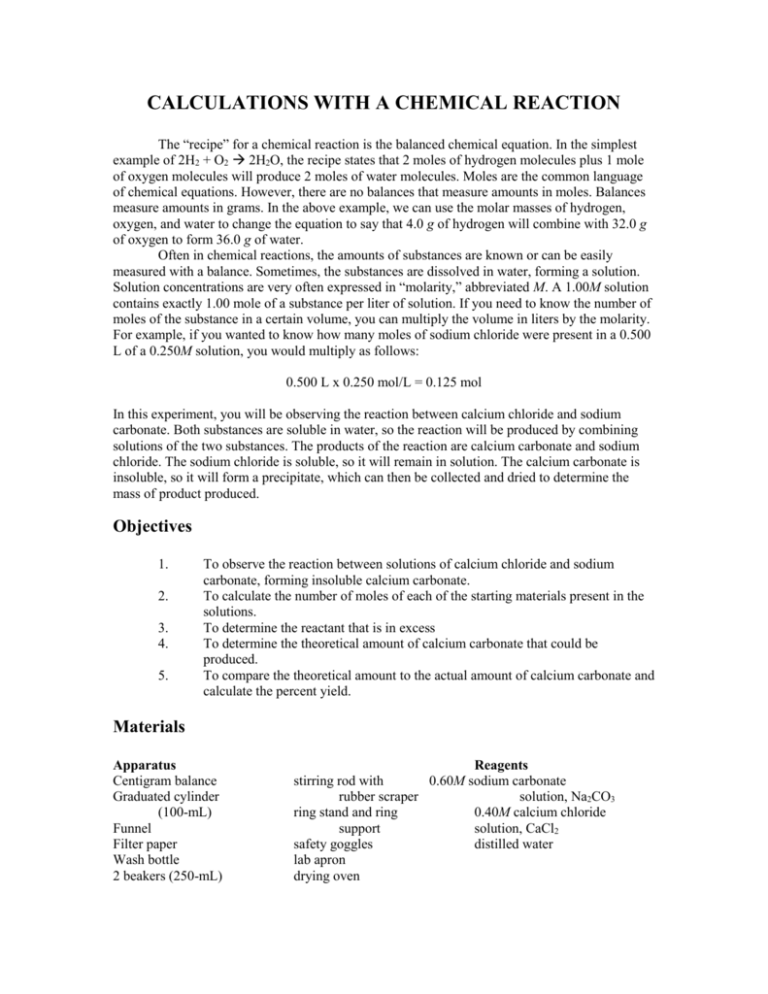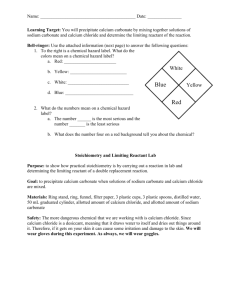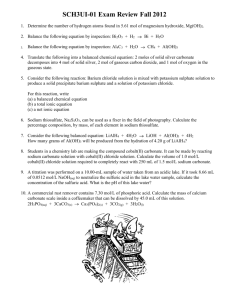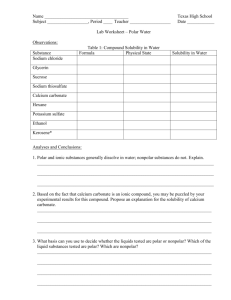CALCULATIONS WITH A CHEMICAL REACTION
advertisement

CALCULATIONS WITH A CHEMICAL REACTION The “recipe” for a chemical reaction is the balanced chemical equation. In the simplest example of 2H2 + O2 2H2O, the recipe states that 2 moles of hydrogen molecules plus 1 mole of oxygen molecules will produce 2 moles of water molecules. Moles are the common language of chemical equations. However, there are no balances that measure amounts in moles. Balances measure amounts in grams. In the above example, we can use the molar masses of hydrogen, oxygen, and water to change the equation to say that 4.0 g of hydrogen will combine with 32.0 g of oxygen to form 36.0 g of water. Often in chemical reactions, the amounts of substances are known or can be easily measured with a balance. Sometimes, the substances are dissolved in water, forming a solution. Solution concentrations are very often expressed in “molarity,” abbreviated M. A 1.00M solution contains exactly 1.00 mole of a substance per liter of solution. If you need to know the number of moles of the substance in a certain volume, you can multiply the volume in liters by the molarity. For example, if you wanted to know how many moles of sodium chloride were present in a 0.500 L of a 0.250M solution, you would multiply as follows: 0.500 L x 0.250 mol/L = 0.125 mol In this experiment, you will be observing the reaction between calcium chloride and sodium carbonate. Both substances are soluble in water, so the reaction will be produced by combining solutions of the two substances. The products of the reaction are calcium carbonate and sodium chloride. The sodium chloride is soluble, so it will remain in solution. The calcium carbonate is insoluble, so it will form a precipitate, which can then be collected and dried to determine the mass of product produced. Objectives 1. 2. 3. 4. 5. To observe the reaction between solutions of calcium chloride and sodium carbonate, forming insoluble calcium carbonate. To calculate the number of moles of each of the starting materials present in the solutions. To determine the reactant that is in excess To determine the theoretical amount of calcium carbonate that could be produced. To compare the theoretical amount to the actual amount of calcium carbonate and calculate the percent yield. Materials Apparatus Centigram balance Graduated cylinder (100-mL) Funnel Filter paper Wash bottle 2 beakers (250-mL) Reagents stirring rod with 0.60M sodium carbonate rubber scraper solution, Na2CO3 ring stand and ring 0.40M calcium chloride support solution, CaCl2 safety goggles distilled water lab apron drying oven Calculations with a Chemical Reaction Name _______________________ Class________ Date ___________ Prelab Questions 1. What is the number of moles present in 24.0 mL of 0.500M solution of sodium chloride, NaCl? __________________________________________________________________ ________________________________________________________________________ 2. How many moles are there in 456 g of calcium fluoride, CaF2? _____________________ ________________________________________________________________________ 3. What is the formula for: a. sodium carbonate? _________ b. calcium chloride? _________ c. calcium carbonate? _________ d. sodium chloride? _________ 4. What is the purpose of removing all the precipitate from the inside of the beaker? ______ ________________________________________________________________________ 5. In the procedure, there are several washings of the solid with water. What is the purpose of these washings? ________________________________________________________ 6. Why is it important that the solid be dry before the final mass measurement? __________ ________________________________________________________________________ Data and Observations Volume of sodium carbonate solution _________ mL Volume of calcium chloride solution _________ mL Describe what happens after mixing the two solutions: __________________________________ Mass of dry filter paper _________ g Mass of filter paper + dry solid _________ g Conclusions 1. Calculate the following values. Show your work. a. Moles of sodium carbonate used _________ mol b. Moles of calcium chloride used _________ mol c. Mass of calcium carbonate used _________ g d. Moles of calcium carbonate produced _________ mol e. What mass of sodium chloride would be produced (assuming a 100% yield)? _____________ 2. How would you be able to recover the sodium chloride from the solution? ____________ ________________________________________________________________________ 3. A similar reaction occurs when barium chloride solution is mixed with sodium carbonate solution. Write a balanced equation for the reaction. _____________________________ 4. Calculate each of the following for the reaction that occurs when 56.0 mL of 0.50M barium chloride solution is mixed with 78.0 mL of 0.75M sodium carbonate solution: a. Moles of barium chloride added _____________ b. Moles of sodium carbonate added _____________ c. Mass of barium carbonate produced, if the yield is 78% _____________






